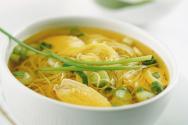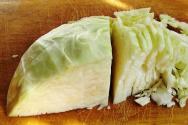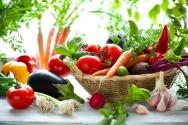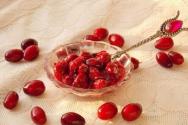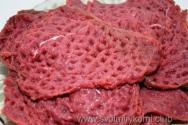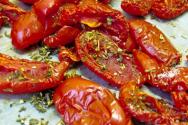A vegetable broth recipe is an indispensable knowledge for a housewife. How to make vegetable broth from what you can find in the kitchen How to make delicious vegetable broth
Vegetable broth- this is nothing more than a decoction obtained by boiling vegetables. It is very simple to prepare, although there are some secrets of preparation and composition of products that should be taken into account when cooking the dish.
Cooks distinguish broths by the number of ingredients included in the finished product. The decoction can be either multi-component or single-component - everything will depend on the needs and desires of the cook.
Vegetable broth in its pure form can be a first course. It is also easy to prepare many other dishes based on it. A broth is prepared from vegetables boiled in a small amount of water without adding meat, cereals, pasta or animal fats. The presence of a small amount of vegetable oil and salt in the finished product is completely acceptable.
Use in cooking
Vegetable broths are widely used in cooking. The product is used both for dietary soups and as a base for baking.
I once heard from a rather experienced housewife that deep-fried pies turn out more airy when the dough is prepared in the broth left after boiling the potatoes. Having become interested in the theory of preparing delicious baked goods, we immediately tested it on our own experience. And the result turned out excellent! We have never eaten such fluffy pies stuffed with crushed potatoes before.
Using vegetable broth, soup with sorrel and various pureed soups, for example, with cauliflower and cheese, are quite tasty. When preparing stews, sauces, gravies, porridges (including risotto), this low-calorie and healthy product is also very often used.
The composition of vegetable broth for each specific dish will be different; for example, to prepare buckwheat soup, both mushroom broth and broth made from potatoes can be used.
Lenten borscht can also have different bases. The broth can be either a decoction of mushrooms or beans, into which all other components will be added according to the recipe, or a decoction obtained from grated beets, into which the remaining components will also be placed in the order specified by the recipe. Celery root or parsnip will add a special flavor to this dish.
Beetroot decoction, which can be classified as a one-component vegetable broth, is also used to prepare kholodnik - a delicious soup without cooking, similar to the beloved okroshka and containing a large number of different ingredients. This dish is consumed exclusively cold.
Various vegetable broth soups are used in the dietary nutrition of preschool children, including infants.
Also, vegetable broth can be used in the diet of pregnant women and nursing mothers, as well as people suffering from pancreatitis or gastritis of various forms and complications after them. Vegetable broths also find their use in the diet of people who adhere to the principles of separate nutrition, as well as those who observe dietary restrictions, pursuing the goal of losing excess weight and losing weight quickly without harming the body. In this case, cabbage broth helps best. They even developed a “cabbage diet” based on it. I have verified from my own experience that this method gives positive results.

How to cook it correctly?
How to properly prepare delicious vegetable broth? This question can often be heard from young and inexperienced housewives, so we will try to answer it in this section of the article.
The youngest housewife can handle this task, as long as she adheres to the mandatory rules:
- To prepare a delicious vegetable broth, it is imperative to select only high-quality products that have reached commercial maturity and have no visible spoilage.
- All products must be washed and cleaned if necessary. The latter applies more to root crops.
To prepare bean broth, for example, you should take into account the fact that the product itself takes a very long time to cook, so it is advisable to soak the beans in a small amount of cold water for an hour, and then, after draining the water, repeat the procedure twice more. Then, when cooking, you will be pleasantly surprised, because in a regular pan the beans will be ready in half an hour, and you will not see a large amount of foam. Therefore, soup based on bean broth can even be prepared in a slow cooker without fear!
Cooking broth, the main component of which is mushrooms, especially those collected from the wild, also has some peculiarities. To obtain a clean and aromatic broth, cooks recommend putting the main product in the pan entirely, and boiling it twice, draining the resulting broth and replacing it with clean water. Experienced chefs also stipulate that mushrooms must be pre-soaked in cold salted water for one hour immediately before cooking. This will reveal hidden pests inside the stem and cap. Dried mushrooms intended for subsequent use in broths are also recommended to be filled with water. This will allow the product to recover to its previous size and reach readiness faster.
The listed types of broths can be used to replace fatty meat broths that are difficult for the stomach, and the nutritional value of the dishes will not be affected.

Creation principle
The principle of creating a delicious vegetable broth, or more precisely, its technique, is suitable for any combination of products. There are only a few basic rules, which we will try to talk about in the descriptions of basic recipes.
Mushroom broth is very easy to make. Place in a deep saucepan:
- 300 grams of fresh mushrooms, washed and cut into several pieces;
- 100 grams of carrots, cut into slices;
- 50 grams of grated celery root;
- 100 grams of finely chopped onions;
- 2 leaves of washed bay leaf;
- one sprig of dill and parsley;
- half a teaspoon of salt.
Fill everything with two liters of cold purified water and put it on medium heat. After boiling, reduce the heat and cover the pan with a lid. After 25 minutes, turn off the heat, remove the bay leaf and let the broth brew for ten minutes. We filter the rich broth through cheesecloth and use it as a base for soup or for preparing other dishes.

You can see the finished product in the photo.
Classic broth can be used to make clear soups and light gravies.
- To prepare this dish you will need to peel, rinse and chop:
- 200 grams of tomatoes;
- 100 grams of peeled bell pepper;
- 100 grams of fresh carrots;
- 100 grams of onions;
- 30 grams of greens;
a few sprigs of thyme. Place all ingredients in a saucepan and cover with cold water. The dish should be cooked over low heat for no more than twenty minutes after boiling. There is no need to salt the product, because tomatoes will give the broth a complete taste. In winter, when there are no more ground tomatoes and peppers, and those grown in a greenhouse or in distant warm countries do not have a pronounced taste and aroma, dried mixtures of sweet bell peppers and tomatoes can be used to enhance the taste.
The finished broth should be cooled for twenty minutes and then strained through a fine strainer. If you do not aim to follow a low-calorie diet, you can season the dish with sour cream or add a little butter to it.

As you can see, there is nothing complicated in preparing vegetable broth, because vegetables can be arranged in a variety of ways. You just need to take into account the taste characteristics of each of them and the personal preferences of the taster. About them in the table below:
|
Ingredients |
Gives the broth: |
|
sweetness and yellow color; |
|
|
Onion |
enhances the taste and aroma of main products, does not affect color; |
|
Celery and parsnips |
will add aroma and enhance the taste of the remaining components; |
|
White and cauliflower cabbage |
will saturate with aroma, but will make the broth cloudy; |
|
Red cabbage |
saturates with aroma and gives a purple tint; |
|
Red bell pepper |
will saturate it with its own scent and give it a pink color; |
|
Yellow bell pepper |
will saturate with its own smell, but will not change the original color of the decoction; |
|
Fresh tomato |
sourness and pinkish tint; |
|
sweetness and rich burgundy color, and if boiled enough, the broth will turn light brown; |
|
|
specific taste, sometimes oily, the color of the broth can vary from light yellow to dark brown. |

Secrets of obtaining and storing broth
The secrets to getting a delicious broth are to follow some rules.
- All ingredients (vegetables, herbs, and spices) need to be thoroughly cleaned and washed several times before storing.
- To obtain a high-quality and rich broth, vegetables should always be immersed in cold water, because it is during the boiling process that the ingredients release vitamins and minerals.
- The product must be salted immediately when adding the components. This will allow the products to reveal their best taste qualities. But you should not add the entire amount of salt, because during the cooking process the initial amount of liquid decreases and the finished broth may become too salty.
- It is best to use dried herbs for flavoring broths, because their aroma is more intense compared to the fresh product.
- Under no circumstances should you put fresh garlic in a dish so as not to spoil the taste, but the use of dried grated garlic, especially as part of seasonings and aromatic mixtures, on the contrary, very beneficially accentuates the taste of the finished broth.
- If the intended dish allows, it is recommended to fry the vegetables in vegetable oil until golden brown before boiling. And then just fill them with water.
It is not recommended to store the resulting concentrated broths for longer than six hours, because only this product contains the largest amount of vitamins. But experienced housewives always have a portion of the dish prepared for future use. The freezer helps them with this. And they do it this way: the cooled broth is poured into portioned containers or plastic bags and then frozen. The ice cubes are used in the same way as a freshly prepared product.

The briquettes do not need to be defrosted first, because it will be enough to put them in a container with a small amount of hot water.
Benefits of vegetable broth The benefits of vegetable broth are obvious.
It manifests itself in high nutritional value and vitamin content and easy digestibility of the product by the body. That is why such decoctions are the preferred dishes during the recovery period after abdominal surgery and various diseases of the gastrointestinal tract. The only exceptions are dishes containing beans and cabbage, in order to avoid additional stress on the stomach.
Vegetable broths contain all the beneficial substances and vitamins contained in the ingredients. There are no contraindications to eating the dish, except perhaps individual intolerance to any components, but in this case they can simply be excluded from the list or replaced with others.

Vegetable broths have a beneficial effect on the digestive system and intestines. This improves the condition of hair, nails and skin, improves complexion and general condition of the body. And all because fresh vegetables contain a large amount of fiber.
What to replace it with? How to replace vegetable broth if you suddenly can’t cook it? It would seem that there is no complete replacement for this product.
Dry preparations for broths must be used strictly in accordance with the recommendations indicated on the packaging, because they may contain salt.
Of course, dry broth cannot be a complete replacement for natural broth, but in some cases its use is quite justified. I would like to note that products may contain both public and hidden food additives, so you should not abuse such a product. It is advisable to give preference to a natural dish prepared from fresh vegetables.
We hope that this article was informative and useful; you were able to learn how to cook vegetable broth and a light diet soup based on it, as well as prepare a tasty and nutritious first course for lunch without meat.

For a good broth you will need:
- 1–2 onions;
- 2–3 carrots;
- 4–5 celery stalks along with herbs;
- 1 bunch of any greenery (you can use several sprigs of parsley, dill, green onions, thyme and other herbs);
- 3–5 cloves of garlic;
- salt - to taste;
- 7–10 black peppercorns;
- water - as much as needed.
The following products will perfectly complement the taste:
- 2–3 dried bay leaves;
- 1 leek along with herbs;
- 2–3 tomatoes or 1–2 tablespoons of tomato paste;
- 1 bell pepper;
- several fresh or dried mushrooms.
If desired, add other vegetables that you can find in the kitchen. Sometimes broth is even made from unnecessary vegetable trimmings or added to other products.
Trimmings can be stored in special containers for such cases. Naturally, they must be clean. So wash your vegetables and herbs thoroughly if you are going to use their peels for broth.
Frozen scraps of vegetables and herbs from which you can cook broth / aspicyperspective.com
How to make vegetable broth
Rinse vegetables and herbs thoroughly. Onions and garlic can be used together with the skin, and carrots can simply be rubbed thoroughly with a brush.
Cut the vegetables into large pieces. The greens can also be coarsely chopped or left whole.
If you add fresh mushrooms to the broth, cut them into large pieces as well. Dried mushrooms must first be soaked in hot water for 20–30 minutes.
Place all prepared ingredients in a saucepan, add salt, pepper and bay leaves and cover with water. It should completely cover them. The less water, the more concentrated the broth will be.
Bring the liquid to the first bubbles over medium heat. Then reduce it and cook for 1-2 hours.
YouTube channel The Domestic Geek
Use a slotted spoon or drain the ingredients in a colander and strain the broth through a sieve. Vegetables and herbs will no longer be useful - they have already given all their taste and aroma to the broth.
YouTube channel The Domestic Geek
How to store vegetable broth
If you do not plan to use it right away, pour the cooled broth into a jar or container with a lid and put it in the refrigerator. There he should stay no longer than 1 week.
The broth can also be frozen in a suitable container. It can be stored in the freezer for up to 3 months.
Products
Water - 2 liters
Vegetable oil - 2 tablespoons
Onion - 1 piece
Carrots - 2 pieces
Parsley root - 1 piece
Tomato - 1 piece
Garlic - 2 cloves
Parsley - 6 sprigs
Dill - 6 sprigs
Thyme - 3 sprigs
Black pepper - 5 peas
Bay leaf - 2 jokes
Salt - 1 teaspoon
Food preparation
1. Wash and peel vegetables (carrots, onions, tomatoes, parsley root), chop finely.
2. Place vegetables in a cooking container (saucepan or slow cooker).
How to cook vegetable broth in a saucepan
1. Pour water (2 liters) over the vegetables, add salt, pepper, bay leaf; add sprigs of herbs (parsley, dill, thyme) and garlic (put it in the form of whole cloves). 2. Place the pan with the future broth on high heat, after boiling, reduce the heat, cover the pan with a lid.
3. Cook the broth for another 20 minutes.
How to cook vegetable broth in a slow cooker
1. Place vegetables at the bottom of the bowl, add vegetable oil, turn on the “Baking” mode and fry the vegetables for 20 minutes.
2. Pour water (2 liters) over the vegetables, add sprigs of herbs (parsley, dill, thyme) and garlic.
3. Add seasonings (salt, pepper and bay leaf).
4. Turn on the “Stew” mode, close the multicooker with a lid and cook the broth for another 60 minutes.
Your vegetable broth is cooked! Strain the finished broth through a sieve and remove the vegetables.
Preparing vegetable broth is not as difficult as it seems - the main thing is to make it aromatic and transparent. This is a great soup base if you are on a diet or have given up meat.
Vegetable broth is used in many dishes. Soups and puree soups are prepared with it, used for sauces, stewing fish and meat, and added to risotto and stews. We have collected several recipes from chefs that we share with you.
Vegetable broth from Gordon Ramsay
The recipe for this broth is described in the book “Chef's Secrets”, and the main secret of the cook is to let the broth brew. It's best to prepare it the day before you use it. You will need:
- 3 onions, coarsely chopped
- 1 stalk chopped leek
- 6 carrots, chopped
- 1 head of garlic, cut in half
- 1 lemon, coarsely chopped
- 1 bay leaf
- star anise to taste
- black peppercorns
- allspice peas
- bouquet of herbs: basil, cilantro, thyme, parsley
- 2 liters of water
- 200 milliliters dry white wine
Place all the vegetables, garlic, lemon, peppers, bay leaves and star anise in a deep, thick-walled pan and add water. Bring to a boil, reduce heat, cover and simmer for 10 minutes.
Then remove the pan from the heat, add a bouquet of herbs, wine and cool so that the broth absorbs the aroma of the seasonings. Place the cooled broth in the refrigerator for a day to infuse. Then strain and store in the refrigerator for up to 3 days. The broth can be frozen in portions - this will keep it longer.
Vegetable broth from Heston Blumenthal
To make the broth for this recipe, you may need a food processor to reduce prep time. Heston Blumenthal takes a scientific approach to everything, and he believes that chopped vegetables will impart more flavor to the broth. The above ingredients will make about 2 liters of broth, so you can reduce the amount or freeze the finished broth for future use. You will need:
- 50 grams of butter
- 350 grams thinly sliced leeks
- 225 grams thinly sliced carrots
- 200 grams finely chopped onion
- 200 grams chopped mushrooms
- 100 grams finely chopped celery stalk or tuber
- 3 sprigs thyme
- 3 bay leaves
- 30 grams parsley leaves
Melt the butter in a heavy saucepan, add the chopped vegetables and fry them, stirring occasionally. If you use a pressure cooker, it will take 5 minutes, but if you use a simple saucepan, it will take from 15 to 25 minutes.
Add thyme, bay leaf and 2 quarts of ice water. Bring to a boil over high heat, then reduce heat and simmer the broth for about an hour. Then remove the pan from the heat, cool, return to medium heat and simmer for another 15-20 minutes. Add the parsley leaves, remove from the heat and leave for about an hour. The broth can then be strained and refrigerated or frozen in portions.

Martha Stewart Vegetable Broth
This recipe is from the book “Martha Stewart Cooking School”. Depending on your taste, you can add more aromatic spices - garlic or herbs. You will need:
- 3 tablespoons olive or other vegetable oil
- 1 large onion
- 2 large stalks of celery
- 2 medium carrots
- 2 cloves garlic
- 4 sprigs thyme
- 8 sprigs parsley
- 8 sprigs basil
- 2 bay leaves
- black peppercorns
- pepper
Peel the onion and cut in half. Leave one half whole, thinly slice the second. Cut the celery and carrots into cubes, chop the garlic. Heat oil in a thick pan, add chopped onion and fry until golden brown. Add celery, carrots, garlic and peppercorns, stir-fry until vegetables are golden and soft.
Pour in enough water to cover the vegetables by 2.5-3 centimeters. Add herbs and half an onion. Season with salt and pepper and bring to a boil. Reduce heat so that the broth does not boil too much and simmer for an hour without covering with a lid.
Strain the finished broth, squeeze the vegetables well so that they release all their flavor. Cool and refrigerate or freeze.

Vegetable Broth from Epicurious
Epicurious is one of the most famous Western cooking sites. Vegetable broth prepared according to this recipe is perfect for Asian soups. You will need:
- 1 tablespoon vegetable oil
- 2 medium onions, cut into wedges
- 10 celery stalks, sliced
- 2 large carrots, cut into slices
- 220-250 grams of mushrooms
- 1 head of garlic, halved
- 6 sprigs parsley
- 1 bay leaf
- 1 teaspoon peppercorns
Heat the oil in a heavy saucepan, add the vegetables and fry them for 5-7 minutes until they begin to turn golden and soft. Pour in about 3.5 liters of cold water and bring to a boil. Reduce heat and simmer until broth is reduced by half - this will take about 1.5 hours. Strain the finished broth.

Simple vegetable broth
This recipe is from Tal Ronnen, a vegetarian chef based in Los Angeles. This is perhaps the simplest recipe of all. You will need:
- 3.5-4 liters of water
- 2 teaspoons black peppercorns
- 1 teaspoon salt
- 12 sprigs parsley
- 6 sprigs thyme
- 4 cloves garlic
- 2 bay leaves
- 2 stalks of celery
- 2 carrots
- 2 leeks
- 1 onion
Crush the garlic, cut the carrot and onion in half. Coarsely chop the leek and celery. Place all ingredients in a large saucepan and add water. Bring to a boil, reduce heat and simmer for about 45 minutes. Strain the finished broth.

- You can add unpeeled onions to the vegetable broth: this will give the broth a pleasant golden color.
- You need to salt the vegetable broth at the very beginning - salt will help draw out the flavor from the vegetables.
- Adding dry white wine or wine vinegar will improve the taste because the acid works in the same way as salt - it draws out the flavor from the vegetables.
- If you pre-fry the vegetables, the taste of the broth will be richer and the color brighter.
- Adding a few sun-dried tomatoes or a couple of mushrooms to the broth will enhance the flavor and darken the color.
- Good water plays a huge role in making broth. , and vegetable broth should be cooked in soft, bottled or filtered water, so the broth will be more tasty.
2690 2018-08-29
It is very convenient to collect vegetable trimmings for broth for some time in an airtight container that can be stored in the refrigerator or in. Collect useful preparations by putting washed trimmings from sweet peppers and remains from petiole peppers there; top layers of leek “butts”, celery root; stems of greenery. When the container is full, you can add all this when cooking the broth.
Vegetable broth is a dietary dish. Just like chicken, it can be prepared for convalescent people, included in the diet or dietary dishes can be prepared based on it; it is included in the diet.
And water is the basis of vegetable broth. By the way, it is recommended to use filtered water for this broth, not running tap water, or mineral water without gases, because the taste of the broth depends on the quality of the water. Also, all sorts of spicy and spices are added to vegetable broths; they can be placed in a linen bag or a special strainer so that they do not make the broth cloudy.

add to taste; you don’t have to add salt to the dietary version; due to the aromatic and fresh vegetables, the broth will be rich and tasty. It is recommended to add salt to the vegetable broth immediately: salt helps draw out the aromas and taste from the vegetables. But when using it to prepare another dish, do not forget that the broth is salted; then it is better not to salt the “workpiece”.
You can add almost any aromatic vegetables you have on hand to vegetable broth. But, if this is a “prepared” broth, then you should not put sweets and cabbage in it. Because their smell will dominate and will cover the taste and aroma of not only the broth, but also the dish to which it will be added. Important:
When you add leek parts, you can get a brown broth, keep this in mind if it is important for you to get a clear broth. carrots, fennel (usually its outer parts are too rough for, but good for broth), onions - onions and leeks, any part of celery (tuber, stalk, leaves or a little of everything). Tuberous celery is the most accessible of the “white roots”, but if you have parsley or parsnip root on your farm, then it wouldn’t hurt to add that too.
For a deeper and richer taste of the broth, you should add a couple of dried or slightly sun-dried tomatoes, but this will also change the color of the broth. You can add asparagus, basil, but this is also to taste.
Acid helps enhance the aroma of vegetables and revive the taste, so you can add a spoonful of white wine or a little dry white wine to the broth.

All-Purpose Vegetable Broth
For 1.5 liters of prepared broth
What we need (in general, vegetables can be seasonal, your choice):
- 1.8 liters of water
- 50 ml dry white wine or 2 tsp. white wine vinegar
- 3/4 teaspoon coarse sea salt
- 1 onion
- 1 leek
- 2 small carrots
- 1 parsley root (or a piece of celery tuber weighing 50-70 g or a small parsnip)
- 1-2 celery stalks (optional)
- 1/4 fennel bulb (optional)
- 1 small tomato or half a large one
- 5-7 stems or sprigs of parsley or cilantro
- 5-7 stems or twigs
- 3-4 sprigs of thyme (optional)
- 2-3 unpeeled garlic (to taste)
- 5-7 black peppercorns
- 5-7 peas of allspice (preferably)
- 1-2 sheets
- 1 tbsp. olive oil
Preparation:
- Thoroughly peel and rinse all vegetables, then cut into small pieces of arbitrary shape. Place in a wide saucepan, preferably with a thick bottom, add sprigs of herbs, unpeeled cloves of garlic (so that if it accidentally boils, it does not make the broth cloudy), salt, pepper, bay leaf.
- Pour wine and water into a saucepan and place over medium-high heat. *To obtain a high-quality and rich broth, vegetables should always be immersed in cold water, because it is during the boiling process that the ingredients release and.
- At the end you can add a spoon of olive oil.
- The finished broth should be cooled, and then you can strain the broth through a sieve, lightly squeezing the vegetables. Use the broth immediately, or pour it out for storage and later use.
- Once the broth boils, reduce the heat to medium. The broth is prepared quickly, usually no more than 25-30 minutes from the moment of boiling. Some people prefer to saute vegetables in oil, but it will be healthier to add them in their natural fresh form. You can bake vegetables in oil and spices, and then cook broth from them.
You don’t need to add salt to the broth; tomatoes will give the broth a complete taste. In winter, when there are no more ground tomatoes, and those grown in a greenhouse or in distant warm countries do not have a pronounced taste and aroma, dried mixtures of sweet bell peppers and tomatoes, or any natural concentrates from dried vegetables, can be used to enhance the taste.
You can combine vegetables in a variety of ways. You just need to take into account the taste characteristics of each of them and the personal preferences of the taster.

Benefits of vegetable broth
Vegetable broths have a beneficial effect on the digestive system and
